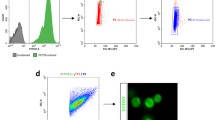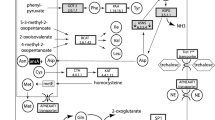Summary
All aphids harbor symbiotrophic prokaryotes (“primary symbionts”) in a specialized-abdominal cell, the bacteriocyte. Chaperonin 60 (Cpn60, symbionin) and chaperonin 10 (Cpn10), which are high and low molecular weight heatshock proteins, were sought in tissues of more than 60 aphid species. The endosymbionts were compared immunologically and histologically. It was demonstrated that (1) there are two types of aphids in terms of the endosymbiotic system: some with only primary symbionts and others with, in addition, secondary symbionts; (2) the primary symbionts of various aphids are quite similar in morphology whereas the secondary symbionts vary; and (3) irrespective of the aphid species, Cpn60 is abundant in both the primary and secondary symbionts, while Cpn10 is abundant in the secondary symbionts but present in small amounts in the primary ones. Based on these results, we suggest that the primary symbionts have been derived from a prokaryote that was acquired by the common ancestor of aphids whereas the secondary symbionts have been acquired by various aphids independently after divergence of the aphid species. In addition, we point out the possibility that the prokaryotes under intracellular conditions have been subject to some common evolutionary pressures, and as a result, have come to resemble cell organelles.
Similar content being viewed by others
References
Bochkareva ES, Lissen NM, Girshovich AS (1988) Transient association of newly synthesized unfolded proteins with the heat-shock GroEL protein. Nature 336:254–257
Buchner P (1965) Endosymbiosis of animals with plant microorganisms. Interscience, New York
Chandrasekhar GN, Tilly K, Woodford C, Hendrix R, Georgopoulos C (1986) Purification and properties of the groES morphogenetic protein ofEscherichia coli. J Biol Chem 261: 12414–12419
Cheng MY, Hartl FU, Martin J, Pollock RA, Kalousek F, Neupert W, Hallberg EM, Hallberg RL, Horwich AL (1989) Mitochondrial heat-shock protein hsp60 is essential for assembly of proteins imported into yeast mitochondria. Nature 337: 620–625
Davis BJ (1964) Disc electrophoresis II. Method and application to human serum proteins. Ann New York Acad Sci 121:406–427
Douglas AE, Dixon AFG (1987) The mycetocyte symbiosis of aphids: variation with age and morph in virginoparae ofMegoura viciae andAcyrthosiphon pisum. J Insect Physiol 33:109–113
Fukatsu T, Ishikawa H (1992) Synthesis and localization of symbionin, an aphid endosymbiont protein. Insect Biochem Molec Biol 22:167–174
Goloubinoff P, Christeller JT, Gatenby AA, Lorimer GH (1989a) Reconstitution of active dimeric ribulose biphosphate carboxylase from an unfolded state depends on two chaperonin proteins and Mg-ATP. Nature 342:884–889
Goloubinoff P, Gatenby AA, Lorimer GH (1989b) GroE heat shock proteins promote assembly of foreign prokaryotic ribulose biphosphate carboxylase oligomers inEscherichia coli. Nature 337:44–47
Griffiths GW, Beck SD (1973) Intracellular symbiotes in the pea aphid,Acyrthosiphon pisum. J Insect Physiol 19:75–84
Hara E, Ishikawa H (1990) Purification and partial characterization of symbionin, an aphid endosymbiont-specific protein. Insect Biochem 20:421–428
Hara E, Fukatsu T, Kakeda K, Kengaku M, Ohtaka C, Ishikawa H (1990a) The predominant protein in an aphid endosymbiont is homologous to an E. coli heat shock protein. Symbiosis 8:271–283
Hara E, Fukatsu T, Ishikawa H (1990b) Characterization of symbionin with anti-symbionin antiserum. Insect Biochem 20: 429–436
Hemmingsen SM, Ellis RJ (1986) Purification and properties of ribulosebiphosphate carboxylase large subunit binding protein. Plant Physiol 80:269–276
Hemmingsen SM, Woodford C, van der Vies SM, Tilly K, Dennis DT, Georgopoulos CP, Hendrix RW, Ellis RJ (1988) Homologous plant and bacterial proteins chaperone oligomeric protein assembly. Nature 333:330–334
Hendrix RW (1979) Purification and properties of groE, a host protein involved in bacteriophage assembly. J Mol Biol 129: 375–392
Houk EJ (1987) Symbionts. In: Minks AK, Harrewijn P (eds) Aphids, their biology, natural enemies and control. Elsevier, Amsterdam, pp 123–129
Ishikawa H (1984) Characterization of the protein species synthesized in vivo and in vitro by an aphid endosymbiont. Insect Biochem 14:417–425
Ishikawa H, Yamaji M (1985) Symbionin, an aphid endosymbiont-specific protein I. Production of insects deficient in symbiont. Insect Biochem 15:155–163
Ishikawa H, Yamaji M, Hashimoto H (1985) Symbionin, an aphid endosymbiont-specific protein II. Diminution of symbionin during post-embryonic development of aposymbiotic insects. Insect Biochem 15:165–174
Kirk JTO (1976) Chloroplast nucleic acids. In: Fasman GD (ed) Handbook of biochemistry and molecular biology, nucleic acids, 3rd ed, vol 2. CRC Press, Cleveland, pp 65–240
Laemmli UK (1970) Cleavage of structural proteins during the assembly of the head of bacteriophage T4. Nature 227:680–685
Lecker S, Lill R, Ziegelhoffer T, Georgopoulos CP, Bassford PJ, Kumamoto CA, Wickner W (1989) Three pure chaperone proteins of Escherichia coli-SecB, trigger factor and GroEL—form soluble complexes with precursor proteinsin vitro. EMBO J 8:2703–2709
Lubben TH, Gatenby AA, Donaldson GK, Lorimer GH, Viitanen PV (1990) Identification of a groES-like chaperonin in mitochondria that facilitates protein folding. Proc Natl Acad Sci USA 87:7683–7687
Margulis L (1970) Origin of eukaryotic cells. Yale University Press, New Haven
Margulis L (1981) Symbiosis in cell evolution. Freeman, San Francisco
McLean DL, Houk EJ (1973) Phase contrast and electron microscopy of the mycetocytes and symbiotes of the pea aphid,Acyrthosiphon pisum. J Insect Physiol 19:1245–1254
McMullin TW, Hallberg RL (1987) A normal mitochondrial protein is selectively synthesized and accumulated during heat shock inTetrahymena thermophila. Mol Cel Biol 7:4414–4423
Moran NA (1988) The evolution of host-plant alteration in aphids: evidence for specialization as a dead end. Am Nat 132:681–706
Munson MA, Baumann P, Clark MA, Baumann L, Moran NA, Voegtlin DJ, Campbell BC (1991a) Evidence for the establishment of aphid-eubacterium endosymbiosis in an ancestor of four aphid families. J Bacteriol 173:6321–6324
Munson MA, Baumann P, Kinsey MG (1991b)Buchnera gen. nov. and Buchnera aphicidola sp. nov., a taxon consisting of the mycetocyte-associated, primary endosymbionts of aphids. Int J Syst Bacteriol 41:566–568
Neidhardt FC, Van Bogelen RA, Vaughn V (1984) The genetics and regulation of heat-shock proteins. Ann Rev Genet 18: 295–329
Ohtaka C, Ishikawa H (1991) Effects of heat treatment on the symbiotic system of an aphid mycetocyte. Symbiosis 11:1930
Ohtaka nC, Ishikawa H (1992) Accumulation of adenine and thymine in a groE homologous operon of an intracellular symbiont. J Mol Evol: in press
Ohtaka C, Nakamura H, Ishikawa H (1992) Structure of chaperonins from an intracellular symbiont and their functional expression inE. coli groE mutants. J Bacteriol 174:1869–1874
Profft J (1937) Beitraege zur Symbiose der Aphiden und Psylliden Z Morphol Oecol Tiere 32:289–326
Sasaki T, Hayashi H, Ishikawa H (1991) Growth and reproduction of the symbiotic and aposymbiotic pea aphidsAcyrthosiphon pisum maintained on artificial diets. J Insect Physiol 37:749–756
Tilly K, Murialdo H, Georgopoulos C (1981) Identification of a secondEscherichia coli groE gene whose product is necessary for bacteriophage morphogenesis. Proc Natl Acad Sci USA 78:1629–1633
Unterman BM, Baumann P, McLean DL (1989) Pea aphid symbiont relationships established by analysis of 16S rRNA. J Bacteriol 171:2970–2974
Wallace DC (1982) Structure and evolution of organella genomes. Microbiol Rev 46:208–240
Webb R, Reddy KJ, Sherman LA (1990) Regulation and sequence of theSynechococcus sp. strain PCC 7942groESL operon, encoding a cyanobacterial chaperonins. J Bacteriol 172:5709–5088
Winkler HH, Wood DO (1988) Codon usage in selected AT-rich bacteria. Biochimie 70:977–986
Author information
Authors and Affiliations
Rights and permissions
About this article
Cite this article
Fukatsu, T., Ishikawa, H. Occurrence of Chaperonin 60 and Chaperonin 10 in primary and secondary bacterial symbionts of aphids: Implications for the evolution of an endosymbiotic system in aphids. J Mol Evol 36, 568–577 (1993). https://doi.org/10.1007/BF00556361
Received:
Accepted:
Issue Date:
DOI: https://doi.org/10.1007/BF00556361




